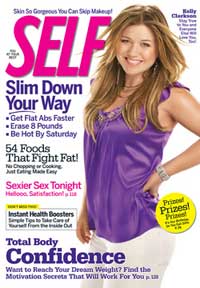One issue that has stayed in my book Mass Communication: Living in a Media World has been the issue of beauty, size and age in magazine advertisements and editorial content. Here is the third of three posts that look these issues over the years that I originally wrote back in 2009.
Is There In Truth No Beauty? Part III
 Self magazine has had it’s own controversy over the honesty of their portrayal of how women look – specifically singer Kelly Clarkson. The American Idol star was featured on the September 2009 cover of the magazine where her image went through the usual digital retouching for color correction and the like. The photo editor also added in a few digital hair extensions, and while he or she was at it, slimmed Clarkson down considerably. Usually such changes are met with denials or statements that there were only minimal changes made. But Self editor-in-chief Lucy Danziger said that when it comes to magazine cover shoots, editors should do whatever it takes to make the cover model look her best. Even if that means changing her body digitally. Danziger writes in her blog:
Self magazine has had it’s own controversy over the honesty of their portrayal of how women look – specifically singer Kelly Clarkson. The American Idol star was featured on the September 2009 cover of the magazine where her image went through the usual digital retouching for color correction and the like. The photo editor also added in a few digital hair extensions, and while he or she was at it, slimmed Clarkson down considerably. Usually such changes are met with denials or statements that there were only minimal changes made. But Self editor-in-chief Lucy Danziger said that when it comes to magazine cover shoots, editors should do whatever it takes to make the cover model look her best. Even if that means changing her body digitally. Danziger writes in her blog:
Portraits like the one we take each month for the cover of SELF are not supposed to be unedited or a true-to-life snapshot (more on that in a moment). When the cover girl arrives at the shoot, she is usually unmade up and casually dressed, and could be mistaken for a member of the crew or the editorial team in many cases. Once we do her makeup and hair, and dress her in beautifully styled outfits and then light her, we then set the best portrait photographer we can on a road to finding a pose and capturing a moment that shows her at her best…
Then we edit the film and choose the best pictures. This is done in tandem with the star; the creative director, Cindy Searight; the photographer; and myself. Then we allow the postproduction process to happen, where we mark up the photograph to correct any awkward wrinkles in the blouse, flyaway hair and other things that might detract from the beauty of the shot. This is art, creativity and collaboration. It’s not, as in a news photograph, journalism. It is, however, meant to inspire women to want to be their best. That is the point.…
Did we alter her appearance? Only to make her look her personal best. Did we publish an act of fiction? No. Not unless you think all photos are that. But in the sense that Kelly is the picture of confidence, and she truly is, then I think this photo is the truest we have ever put out there on the newsstand. I love her spirit and her music and her personality that comes through in our interview in SELF. She is happy in her own skin, and she is confident in her music, her writing, her singing, her performing.
The Today Show also did a story on the Clarkson Self cover. You can view it here:
Usually when we talk about the ethics of digital photo editing, we’re getting at the honesty and authenticity of the image. But in the case of the Clarkson cover, the question is more what kind of message is the magazine sending to its readers. The Clarkson story was about “Total Body Confidence,” but the cover image seems to say that how you really look isn’t good enough.
